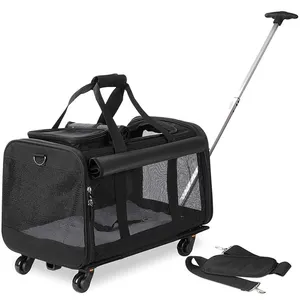
Airline Approved Mesh Breathable Travel Pet Stroller Trolley Dog Cat Backpack Pet Carrier With Wheels



Grasping the fundamental requirements of avian transit, a bird carrier is a purpose-built device for the containment and transportation of birds. These carriers are meticulously engineered to prioritize the well-being, comfort, and convenience of both avian passengers and their human companions during journeys. Bird carriers are available in a plethora of styles, such as cages, backpacks, and tote bags, each customized for specific avian species and travel needs.
Varieties of bird carriers are as varied as the avian species they transport. The classic bird travel cage is versatile, suitable for both stationary and mobile use, and typically comes with a top handle for effortless portability. For the intrepid avian enthusiast, bird carrier backpacks and parrot carrier backpacks provide a hands-free mode of transport, perfect for outdoor excursions like hiking or cycling. The small bird travel cage is ideal for brief outings or veterinary visits, offering a secure haven for petite birds. Meanwhile, carriers designed for white carrier pigeons combine functionality with elegance, mirroring the birds' esteemed status. Each model is tailored to meet the needs of different users, from casual pet owners to seasoned aviculturists, ensuring an appropriate choice for every requirement.
The structure of a bird carrier is crucial to its design. A robust bird travel carrier typically boasts a solid base to bear the weight of the bird and essentials like food and water dishes. The enclosure may feature a blend of materials, such as transparent acrylic for visibility and coated wire or mesh for breathability. Some models are equipped with top-entry systems for convenient access, while others have front doors with secure yet user-friendly latches to prevent avian escape. The addition of detachable trays or liners is a considerate touch, simplifying cleaning without causing disturbance to the bird.
The choice of materials for bird carriers strikes a balance between sturdiness, lightness, and avian comfort. Fabrics like polyester and nylon are preferred for their durability and lightweight properties, facilitating ease of transport. Metals such as stainless steel are selected for their strength and resistance to avian nibbling and scratching. Ventilation is ensured through mesh materials that permit air circulation while being fine enough to prevent self-injury. The trend towards eco-friendly materials is growing, as consumers increasingly demand products that reflect their commitment to sustainability and animal welfare.
The business applications of bird carriers are wide-ranging. Pet retailers utilize them to safely convey birds to and from stores or between locations. Breeders depend on carriers for transporting birds to mating sites or new habitats. Veterinary clinics employ carriers for securing birds pre- and post-treatment, maintaining their tranquility. Wildlife rehabilitators also make use of these carriers for the recuperation and subsequent release of birds into their natural environments. In each instance, the carriers serve not only as a means of transport but also as a safeguard and caretaker for the birds within a commercial setting.
The function of bird carriers transcends mere conveyance. They aim to emulate a bird's natural environment, incorporating elements like perches and swing feeders for comfortable feeding and resting. Some carriers are versatile, transforming into temporary abodes with expandable compartments for extra room. The carrier bird cage can also act as a reassuring sanctuary for birds amidst stressful conditions, offering a touchstone of security and familiarity.
The features of bird carriers set them apart in a competitive marketplace. Adequate ventilation is a paramount feature, achieved through designs that include mesh panels or perforations for proper air exchange. Portability is augmented by adjustable straps, telescoping handles, and wheels. Certain carriers boast adaptable designs, functioning as both backpacks and conventional carriers. The parrot travel cage may come with specialized attributes like UV-resistant materials to protect the delicate eyes of birds from intense sunlight.
The advantages of employing a bird carrier are manifold. They furnish a secure and familiar setting for birds, mitigating the stress of travel. For owners, carriers provide ease and assurance, with the knowledge that their feathered friends are safeguarded and content. The simplicity of upkeep, often featuring machine-washable liners and surfaces that are easy to clean, is essential for maintaining a sanitary habitat, vital for avian health and happiness.
Selecting the appropriate carrier for birds is a decision that warrants careful consideration. The carrier's size is paramount; it should offer ample space for the bird to move freely yet remain manageable for transport. Consideration of the bird's species and disposition is also important, as some may need enhanced ventilation or visibility to stay serene. The nature of the journey will determine the carrier's requisite resilience and features, such as waterproofing for outdoor adventures or cushioning for uneven travels.
Proper maintenance and cleansing of a bird bag carrier are vital for the bird's welfare. Carriers should be sanitized routinely with avian-safe detergents to avert bacterial accumulation and unpleasant odors. Washable liners and trays ought to be laundered separately, and any stained areas on the carrier's body should be addressed immediately. For carriers with metallic parts, it is crucial to inspect for and remedy any signs of corrosion or damage that could pose a risk to the bird.
Guaranteeing the safety of a bird during transit is of utmost importance. A reliable bird transport cage must be devoid of sharp protrusions or insecure elements that could cause harm. It should be positioned in a vehicle in a way that prevents movement or overturning. Acclimatizing the bird to the carrier in a relaxed setting prior to travel can help reduce apprehension. Moreover, frequent checks on the bird's condition are crucial during extended voyages.
Alibaba.com offers an extensive array of bird carriers, each crafted to meet the specific demands of avian transit. With an emphasis on safety, comfort, and elegance, these carriers provide a solution for bird owners eager to journey with their winged companions without sacrificing their well-being.